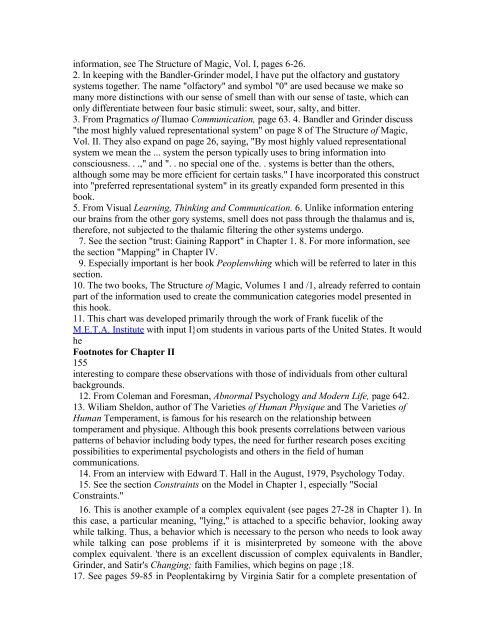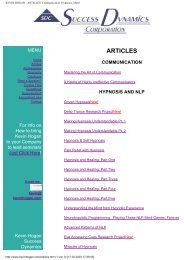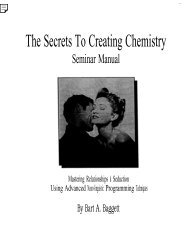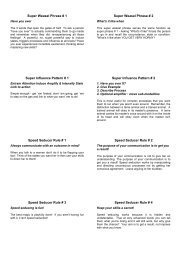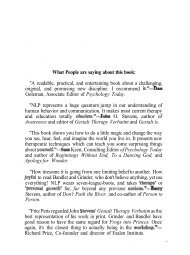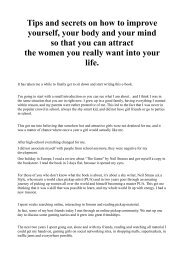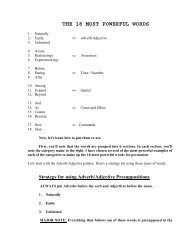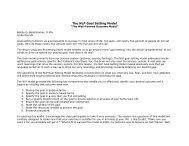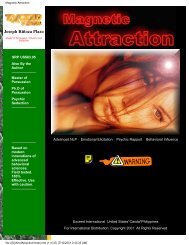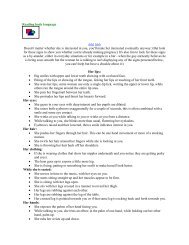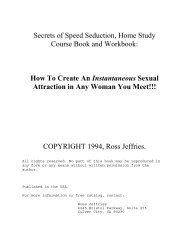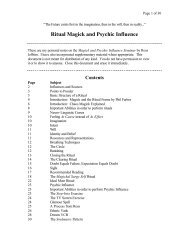A Pragmatic Guide To Communication & Change.pdf - NLP Info Centre
A Pragmatic Guide To Communication & Change.pdf - NLP Info Centre
A Pragmatic Guide To Communication & Change.pdf - NLP Info Centre
- No tags were found...
You also want an ePaper? Increase the reach of your titles
YUMPU automatically turns print PDFs into web optimized ePapers that Google loves.
information, see The Structure of Magic, Vol. I, pages 6-26.<br />
2. In keeping with the Bandler-Grinder model, I have put the olfactory and gustatory<br />
systems together. The name "olfactory" and symbol "0" are used because we make so<br />
many more distinctions with our sense of smell than with our sense of taste, which can<br />
only differentiate between four basic stimuli: sweet, sour, salty, and bitter.<br />
3. From <strong>Pragmatic</strong>s of Ilumao <strong>Communication</strong>, page 63. 4. Bandler and Grinder discuss<br />
"the most highly valued representational system" on page 8 of The Structure of Magic,<br />
Vol. II. They also expand on page 26, saying, "By most highly valued representational<br />
system we mean the ... system the person typically uses to bring information into<br />
consciousness. . .," and ". . no special one of the. . systems is better than the others,<br />
although some may be more efficient for certain tasks." I have incorporated this construct<br />
into "preferred representational system" in its greatly expanded form presented in this<br />
book.<br />
5. From Visual Learning, Thinking and <strong>Communication</strong>. 6. Unlike information entering<br />
our brains from the other gory systems, smell does not pass through the thalamus and is,<br />
therefore, not subjected to the thalamic filtering the other systems undergo.<br />
7. See the section "trust: Gaining Rapport" in Chapter 1. 8. For more information, see<br />
the section "Mapping" in Chapter IV.<br />
9. Especially important is her book Peoplenwhing which will be referred to later in this<br />
section.<br />
10. The two books, The Structure of Magic, Volumes 1 and /1, already referred to contain<br />
part of the information used to create the communication categories model presented in<br />
this hook.<br />
11. This chart was developed primarily through the work of Frank fucelik of the<br />
M.E.T.A. Institute with input I}om students in various parts of the United States. It would<br />
he<br />
Footnotes for Chapter II<br />
155<br />
interesting to compare these observations with those of individuals from other cultural<br />
backgrounds.<br />
12. From Coleman and Foresman, Abnormal Psychology and Modern Life, page 642.<br />
13. Wiliam Sheldon, author of The Varieties of Human Physique and The Varieties of<br />
Human Temperament, is famous for his research on the relationship between<br />
tomperament and physique. Although this book presents correlations between various<br />
patterns of behavior including body types, the need for further research poses exciting<br />
possibilities to experimental psychologists and others in the field of human<br />
communications.<br />
14. From an interview with Edward T. Hall in the August, 1979, Psychology <strong>To</strong>day.<br />
15. See the section Constraints on the Model in Chapter 1, especially "Social<br />
Constraints."<br />
16. This is another example of a complex equivalent (see pages 27-28 in Chapter 1). In<br />
this case, a particular meaning, "lying," is attached to a specific behavior, looking away<br />
while talking. Thus, a behavior which is necessary to the person who needs to look away<br />
while talking can pose problems if it is misinterpreted by someone with the above<br />
complex equivalent. 'there is an excellent discussion of complex equivalents in Bandler,<br />
Grinder, and Satir's Changing; faith Families, which begins on page ;18.<br />
17. See pages 59-85 in Peoplentakirng by Virginia Satir for a complete presentation of


